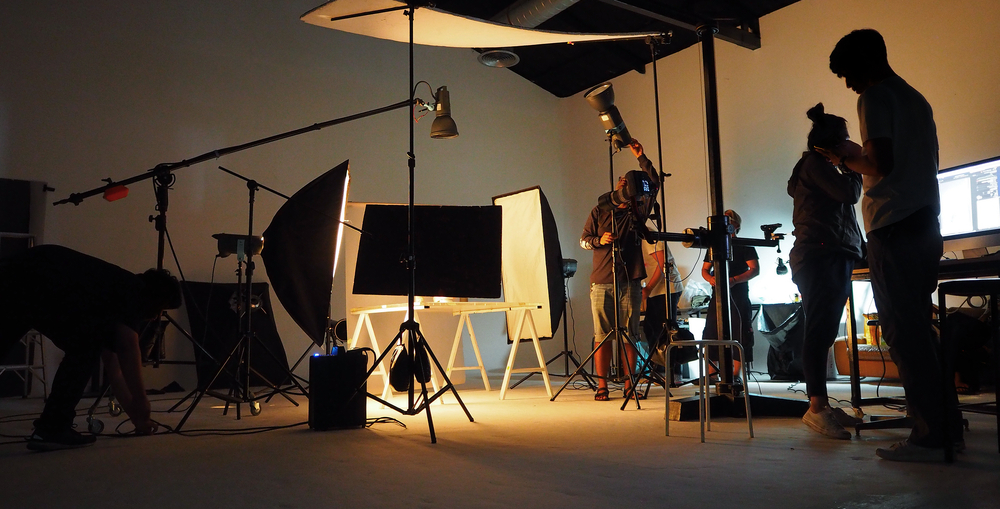
Everything you need to know about stop motion animation
How about creating videos in the same visual style as famous animations, such as The Nightmare Before Christmas, Chicken Run, among others?

What will we see in this post
From bolder animations to home or independent productions, the stop motion technique has been used as an infallible resource to give motion to illustrations.
You have probably heard this term at some point and perhaps, have even watched a few movies that have used this technique. Would you like to know more about stop motion animation and how to use it in your videos? Then keep reading.
What is stop motion?
In this type of animation, an object is photographed several times from the same angle, but with slight changes to its position.
Each photo represents one frame of the plane and, when joined together in sequence, it is possible to create animated videos with a motion effect.

This phenomenon occurs due to an optical illusion known scientifically as persistence of vision. In a nutshell, the human eye retains images formed in the retina for a few tenths of a second, even after the glare that made them disappear.
This way, when we watch a sequence of images of an object projected at 12 frames per second, our brain is “tricked”.
Since the image is recorded on the retina for a few seconds, the next frame is projected at the exact instant in which the previous frame starts to disappear from our “visual memory “. This process causes the sensation of motion in movies and animations.
Generally, each second of an animation shot in stop motion takes about 24 frames. Although it’s a time-consuming and laborious process, the result is very interesting. It’s as if the objects have a life of their own!
Remember that the material used to compose the frames needs to be strong and at the same time, be flexible enough to move in minute scales of time.
This technique might be old, but it’s still being improved in several current audiovisual materials.
Check out the compilation produced by artist Vugar Efendi about the 116-year history of stop motion in movies:
The history of stop motion
This movie technique was revealed by French magician George Mélies. He saw an opportunity to introduce this technique in his illusions.
Mélies improved stop motion for the movies, with A Trip to the Moon becoming a milestone of world filmography. The feature film known for its famous scene of a rocket manned by humans reaching the moon.
If you never watched this masterpiece, check it out:
Developed by several directors, stop motion started to be used in science fiction movies in the 20th century, used as the basis for visual effects, since at the time, the technologies used were rudimentary compared to nowadays.
Follow the evolution of stop motion from the creation of nine filmmakers:
1. James Stuart Blackton
Born in the UK but living in the USA, the filmmaker was a pioneer in animation films. In 1906, James Stuart released the 3-minute short film, The Humorous Phases of Funny Faces, which would be considered as the first animated film recorded on standard picture film.
Although it’s short, this was the first attempt to create an animation in history. The principle was simple: In the beginning, the cartoonist’s hands are included, as he draws the first several lines on the chalkboard in standard live action. From there, the stop-motion technique is used to show what appears to be drawings completing – and then moving – by themselves with no artist on screen.
Check it out:
2. Segundo de Chomón
Segundo de Chomón was a Spanish filmmaker and screenwriter who pioneered the art of stop motion at the beginning of the 20th century. His work was compared to the work of Mélies, because of his refined technique in creating short animations and his use of optical illusions.
Check out excerpts from Electric Hotel, a short produced by this artist:
3. Émile Cohl
The most interesting thing about Cohl’s work, besides having created the cartoon, Fantasmagorie (1908), is the poetic sense of the Parisian artist’s works.
Mixing painting and animation, many of these works were referred to by critics as the “eight art”, for combining animated movies with the classical aesthetics, such as Cubism, Surrealism and Dadaism.
4. Arthur Melbourne Cooper
The British director of photography is known for his pioneering work in stop motion techniques. His filmography with over 300 films in total, date from 1896 to 1915, with 36 being animation movies.
Even after his death, the artist continued to be controversial among movie critics, especially because of this relationship with another important filmmaker, Birt Acres.
This fact, however, does not erase his contributions to animation. Below, you can check out excerpts from Dreams of Toyland (1908):
5. George Pal
This Hungarian-American artist made his mark in the history of cinema, especially because of his contributions to the science fiction genre.
His work was so acclaimed by specialized critics that the animator was nominated seven consecutive times to cinema’s top award (in the short animation film category) from 1942 to 1948. He also received an honorary Oscar in 1944.
6. Jiří Trnka
The Czech artist started his work with animation by creating a puppet theater during World War II. Although he failed in this initiative, Trnka didn’t give up on his work with children’s literature. During the war, he designed stage sets and illustrated books for children throughout the war.
Later, he built his own movie studio in Prague, focused on animation. With his new works, he was awarded at several film festivals in Europe. Many called him the “Walt Disney of Eastern Europe”, especially for his work with stop-motion using puppets.
Check out some of his work below:
7. Jan Svankmajer
This other Czech artist is known in animation film circles thanks to his impacting and surreal drawings. Because of this, he is an inspiration for many contemporary animation filmmakers.
https://youtu.be/1rri69wKUUQ
8. The Quay Brothers and Terry Gilliam
These twins are one of the highlights of contemporary animated movies, especially because of their capacity of combining dolls, puppets and other figures with incredible obscure and impressionistic backdrops.
The pair’s work is of great artistic value, with meticulous aesthetic care. Besides, they combine camera movements with environments that emanate sensations in those who are watching.
It’s no accident that they made history by producing Peter Gabriel’s award-winning Sledgehammer video clip:
9. Tim Burton
He is perhaps one of the most recognized animators of this generation. American filmmaker Tim Burton finds inspiration in the work of artists already mentioned here, such as the Quay Brothers and Jan Svankmajer.
As a horror-movie buff, the director brings many of these references to his animations and adventure movies.
Because of this, his works for children always consist of heavy, almost gothic scenarios. In most of his creations, elements of the real world are blended with personified objects and animals in a surreal tone.
5 programs for making a stop motion video
Now that you’ve read a little about the great pioneers of Stop Motion, how about trying to make your own animation for your videos? We have listed five software that will make this process easier! Check them out:
1. iStopMotion
For USD 19.99 you can download iStopMotion, which is developed for Apple devices.
The tool’ commands are similar professional software, such as devices to view the animation before capturing the frames, features to watch your video instantly, speed up the slow frames, among many other possibilities.
2. iKITmovie
iKITmovie is a creation software for stop motion animations developed for Windows computers.
The program has a green screen and overlay so you can add other backgrounds. You can also edit audio in the program. Therefore, there’s no need to export the animation to another editor when you finish the project.
You can obtain the program and its recent updates for USD 99.00.
3. Stop Motion Pro
Perhaps the Stop Motion Pro is the most complete program, with several advanced animation features.
The biggest emphasis goes to its camera control, which can be changed in the interface after shooting. In addition, it has synchronized overdubbing tools in different languages.
The software can be purchased in several versions, starting at USD 75.00. It’s compatible with Windows computers and a MacOS version is under development.
4. Frameographer
Frameographer is an app developed for iOS devices (iPad, iPhone and iPod) and allows you to capture and export montages in stop motion.
In this program, you can make videos with the front or rear camera, use any audio from the iTunes library, adjust the fps rate, among other features.
It’s available at the App Store and can be downloaded for USD 4.99.
5. Stop Motion Studio
The last program in our list is Stop Motion Studio, which has a major advantage over other programs. It’s compatible with Windows, MacOS, iOS and Android.
The full version starts at USD 1.99, but you can download a trial version, with a few limitations.
Despite this, it has advanced features, such as manual image capturing controls, DSLR camera support, addition of sound effects and the creation of 4K videos.
Have you learned what you need to produce incredible stop motion videos for your business? Well, roll up your sleeves and get to work! But first, make sure you check out other incredible features for your video production. Time flies, and so do digital technologies!
For this purpose, we’ve prepared an article about Motion Graphics so you can get a head start on what is most promising in the creative industry. Click here to access it and enjoy!




